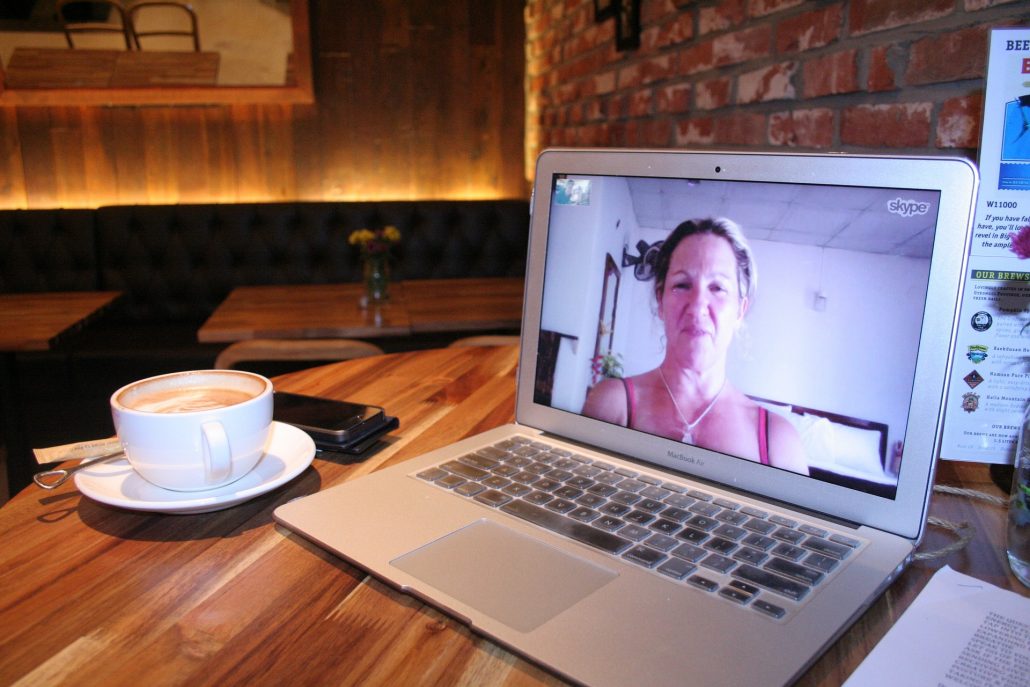Over 90% of Australians own a smart phone, tablet device, laptop or desktop computer. Virtual personal assistants, booking a taxi through an app and even ordering your takeaway food; there’s not much these days that can’t be done online. With most industries in modern society going online, there’s no reason why health care should be any different. Telehealth and telerehabilitation – the use of telecommunications, such as video calling or mobile phone / tablet applications, to provide medical consultations and treatment – are becoming more popular due to the many benefits for both patients and the clinicians. Often patients don’t need hands on therapy but require education and the accountability of a consultation and telehealth provides this perfect balance. Telehealth can be used in both the preventative and curative aspects of injury, for health promotion via education, as well as breaking through geographic, time, social and cultural barriers.
With any new technology, there is always the concern as to whether it can be as effective as traditional methods; however, research has shown that telerehabilitation can be just as effective or even more so than face-to-face consultations and it has also been observed to lower the number of hospital admissions for some conditions through earlier intervention.
Research and the resulting evidence base for the field is constantly expanding with the University of Queensland even having an internationally recognised Centre for Research in Telerehabilitation. Run by experts from multiple health disciplines (physiotherapy, occupational therapy, speech pathology and audiology), the centre co-ordinates research projects investigating the use of telehealth in the rehabilitation of patients. With continued grants and donations, it’s comforting to know that research into telerehabilitation will continue leading to further developments in the field.
A Breakthrough for Patients in Remote and Regional Areas
More than a third of the Australian population lives outside of metropolitan areas. In these communities, life expectancy is unfortunately lower and general health is not as robust as for people who live in the cities.
Historically, the only way these patients living in remote or regional communities could access physiotherapy treatment was to drive extremely long distances or wait for the outreach service from their closest hospital to make a monthly visit. It’s not uncommon for these remote outreach therapy services to have wait lists of approximately six months, delaying treatment for patients who can be in significant pain and limited by their injuries. It also makes follow up appointments extremely challenging if the next therapy visit isn’t for another month (or more). The advance of telehealth means that video-conferencing can be used to access patients in remote, rural and regional areas, allowing them a similar level of access to health care as their city counterparts. They can attend a consultation with a physiotherapist via web cam, who can conduct a modified assessment and prescribe appropriate treatment while also offering education on injury management. Telehealth can run as a stand-alone service or as an enhancement of an existing service and is becoming more popular among regional health providers to improve access for their remote patients and increasing the capacity of their clinicians.
Many patients who live in rural areas run their own properties and work incredibly long hours to make a living. They often don’t accrue sick leave and if they take a day off due to an injury or to attend an appointment, then not only is it money out of their own pocket but their crop or stock can suffer. By using telehealth, farmers may be able to attend an appointment without having to leave their property, instead of having to drive the long distance to the hospital or clinic, drastically cutting down on the time taken away from their important work.
Convenience of Telehealth Services
Health service provision is developing in a similar way to ordering a cab or making a bank transfer. Physiotherapy clinics have online appointment booking capabilities and text message reminders, so it’s not a large leap for the appointment to take place online as well. This allows patients to attend physiotherapy appointments without leaving the comfort of their own home or office. It’s perfect for those with children, as they can plan appointments around nap times without paying for child care or having to bring young children into a clinic.
Busy executives who can’t leave work to attend an appointment can have access physio expertise from their own office. They are then also able to book follow up appointments while travelling overseas for work, solving the problem of losing momentum with their treatment due to work and travel commitments. Telehealth is also being used in industry communities, such as mining sites and offshore oil rigs, where due to the isolating nature of the work, there is no access to health care professionals other than an on-call emergency doctor.
With telehealth, patients can choose a physio practicing anywhere in the world, instead of being limited to their local clinics. This allows the consumer to search for a clinician who might specialise in a specific injury or condition if they wish, allowing them access to genuine experts. There is also a decrease in travel costs and time lost to travel. This is especially helpful for patients in pain having to drive long distances and then drive home again after their appointment when they may possibly be feeling sore post-treatment.

Telehealth allows therapists to connect with patients anywhere, creating much faster access to expert advice
Connecting with the Elderly or Those with Mobility Issues
A large proportion of patients seeking physiotherapy input are in significant pain and thus, some find it difficult to leave their house to attend appointments. Patients with mobility issues are unable to access clinics easily; some common concerns are that stairs result in patients being house-bound or that injuries restrict driving and/or the use of public transport. Taxi fares can become very expensive when used frequently. By opting for telerehabilitation, these patients can benefit from physio treatment without having to navigate stairs, drive or rely on public transport and taxis.
Another area where telehealth is being more commonly used is in residential aged care facilities. Our older population is becoming more tech-savvy and research has shown that after a trial of telerehab, patient mobility and function increases markedly, even in subjects with no experience of interactive technologies or computer games. Residents can either use the tablet device independently if able or with the assistance of a family member or a nursing assistant if required.
Post-operative Patients
One of the most common presenting conditions to a physio clinic is a painful knee because of osteoarthritis. In a study performed by the University of Melbourne comparing knee osteoarthritis rehabilitation models, patients were divided into two groups, one which received therapy via telerehab in the form of Skype consultations and another group which received traditional education and generic exercises. The Skype cohort reported greater increase in physical function and a greater reduction in pain.
When osteoarthritis in the hip or knee becomes severe it often requires the joint to be replaced. For post-joint replacement and other orthopaedic procedures, there is strong evidence to support follow up physiotherapy being conducted via telerehab. Numerous studies have shown good results with telerehabilitation for knee replacement patients and there is growing evidence for effectiveness in hip replacements.
Patients will typically receive a traditional home exercise program from the physiotherapist when discharged from hospital before continuing with follow up appointments via telerehab using a video call on a computer or tablet device. Orthopaedic patients are usually unable to drive for several weeks post operatively, therefore attending their follow up appointments is challenging, obviously, this problem is eliminated with the use of telehealth.
Increased Compliance and Improved Patient Experience
Frequently patients will arrive home with their prescribed exercise program and then forget key instructions or perform the exercise differently to how they did in the clinic, until corrected during their next appointment. Mobile phone applications (some specifically endorsed by the Australian Physiotherapy Association) have been developed which can show pre-recorded videos and instructions of exercises, as well as provide reminders to complete exercises, thus increasing patient compliance. These apps can also include messaging systems which can keep patients and physios in contact in between appointments. Obviously, some boundaries need setting but if it’s simply a case of “I can’t remember what to do with my left foot in this exercise”, a quick interaction can help the accuracy and effectiveness of exercises.
Another positive outcome of telehealth is that it allows patients to have increased independence and self-management of their condition which is especially important in chronic disease. The ownership of their rehabilitation is on them alone and they can often attend a preliminary telehealth appointment for advice while awaiting an in-person consultation with a specialist. This may prevent their condition or pain worsening in the interim. This, in turn, can reduce the number of hospital admissions required for pain relief or medical intervention.
A randomised trial of heart failure patients conducted by physiotherapists at two Brisbane hospitals found that telerehabilitation not only helped improve physical endurance, muscle strength and quality of life but had the added benefit of increased attendance. Patients in the telerehab cohort completed their sessions at home but were linked in with the physiotherapist and other group members so still benefitted from the peer support and encouragement of a group session.
Benefits for Clinicians
It’s not only patients that benefit from using telehealth, therapists can make more efficient use of their time and find they have fewer cancellations and patient no-shows. This increased efficiency allows them to access not only a higher number of patients, but also patients located anywhere in the world. Non-clinical tasks, for example cleaning up a treatment cubicle after each patient has finished, can chew up valuable time. If it takes approximately five minutes after each consultation and 10 patients are seen per day, that’s 50 minutes which would be available in a telerehab model of care. This time could be used for an extra patient consultation slot, showing how telehealth helps to increase the clinician’s capacity.

Treatment, at least for certain conditions, can be just as effective as traditional face-to-face services
Decreased Costs
By increasing patient independence, decreasing the number of hospital admissions and potentially the amount of medication required, telehealth can help to reduce the cost to health care providers. It can also eliminate the need for health-related transport which reduces overall costs and strain on staffing etc.
The macro-economic benefits of remote medical consultations are now the subject of public policy debates and it is likely the governments will want to facilitate an environment that is accommodating for telehealth services.
Potential Barriers to Telehealth
With any new service, there are initial set-up requirements and challenges. Telerehabilitation obviously requires an adequate internet service, something that can be challenging in remote parts of Australia. Hopefully, with the expansion of the National Broadband Network and new 5G technologies, more areas will have sufficient coverage to be able to use telehealth effectively. There are also hardware requirements, i.e., a laptop, tablet, or phone, but the growing ubiquity of these devices should mean that access for all is not far away.
Currently, private health insurance in the UK, USA, Canada and The Netherlands provide rebates for telehealth treatment sessions, but as yet neither Medicare nor Australian private insurance providers recognise it, meaning the patient must pay the full fee for the consultation.
Obviously, telehealth and telerehabilitation aren’t suitable for all patients. Therapists are unable to perform any manual therapy via webcam and some conditions simply require a hands-on assessment and treatment. However, for the patients where it is a feasible option, telehealth has many benefits and will be an important treatment tool in the future of physiotherapy.



